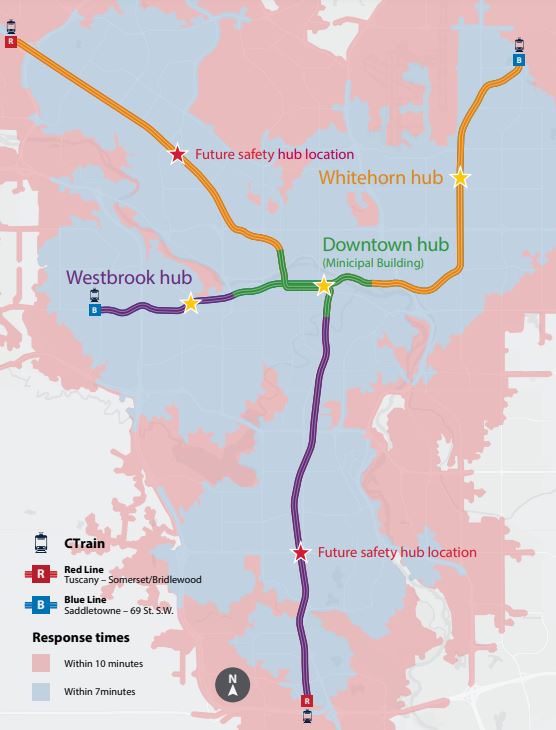A strategy aimed at improving safety through enhanced staffing and quicker response times on Calgary’s public transit system has cleared its first hurdle at city hall, as safety concerns continue to plague Calgary Transit.

The city’s ‘Public Transit Safety Strategy‘ was unanimously approved by the Community Development committee Monday, which will now go to city council for a final say later this month.
The strategy aims to increase the visibility of uniformed and non-uniformed staff on station platforms with an integrated response model between transit peace officers, corporate security, community outreach teams and the Calgary Police Service.
“By transitioning to this, we can better serve Calgarians,” said Aaron Coon, with City of Calgary Community Standards. “But also better align with our partners like Calgary Police Service, our community outreach programs and support more of a regional model throughout the city.”
The proposed model would also see the creation of three safety hubs for transit peace officers along the LRT line at Whitehorn, Westbrook and City Hall; another two hubs near Dalhousie and Anderson stations could also be operational by December, according to officials.
It would also divide the transit system into three districts for transit officers with a goal of responding to incidents within seven to 10 minutes.
Each district would be staffed by 61 transit peace officers with 14 officers per shift, up from the current 12 officers per shift across the entire transit system.
“What I would hope is, as we progress through this strategy and add more peace officers and pivot towards a hub model, that those response times to Calgarians are meeting expectations,” Ward 11 Coun. Kourtney Penner said.
The strategy also calls for further collaboration with resources like the Calgary Homeless Foundation to help those with mental health and addictions issues using the transit network for shelter.
Calgary Police deputy chief Chad Tawfik told city councillors that it’s important to distinguish between vulnerable people needing services and those involved in criminal activity.
Tawfik said Calgary police have interacted with 2,600 unique individuals in vulnerable positions on transit so far this year. Of those, 219 were involved in violent offences like assault.
“We have a fairly small subset that we need to deal with, whether it be through enforcement or other things to try and get them on track,” he said. “But the vast majority are going to need other supports.”
According to new data from the city, 81 per cent of Calgarians surveyed said concern for public safety is considered when deciding whether to take public transit. Meanwhile, 78 per cent said taking the bus feels safer than riding on the LRT.
“One of the major things that make customers feel safe is the visibility of staff,” Leading Mobility Consulting principal David Cooper told Global News. “Having more staff on the system so that if there was an issue to arise, you have the ability to access staff who can get you help. This program does that by providing more coverage across the system.”
Fully implementing the strategy is expected to cost $15 million, which would be debated during the upcoming budget deliberations in November.
It would be the latest in recent investments to improve transit safety following funds to increase transit peace officer staffing by 25 per cent, the addition of security guards and another outreach team, a transit ambassador program, improved lighting at LRT stations and increased integrated patrols to seven nights per week.
Data in the report showed that calls for service to transit officers in 2022 more than doubled from 2018, while ridership was reduced by nearly half due to the COVID-19 pandemic.
Calgary police also experienced a 58-per cent increase in calls for service to LRTs and LRT property over the same timeframe.
“We know we got here over a period of time and it’s not going to change overnight, it’s going to take some time,” Tawfik told reporters. “What you’ll see is a more efficient and effective response with the right resources being brought in at the right time for the right issues.”
Mike Mahar, president of the Amalgamated Transit Union Local 583, which represents transit workers, said he hopes increased response times would include bus routes as well following assaults on drivers over the last couple of years.
“The expectation is really to be protected so that it doesn’t happen,” Mahar told reporters. “When somebody’s assaulting you, you’ve lost all track of time.”
The strategy still requires approval from city council as a whole later this month.




Comments